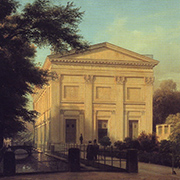Why Mendelssohn when the original Bach is available? The new edition of Bach's "St. Matthew Passion" in Felix Mendelssohn's version offers the possibility of an authentic perfor-mance as in 1829 and 1841.
As Mendelssohn presented Bach’s "Matthäus-Passion" first in 1829 and then again in 1841, he could not have imagined himself as the ‘creator of an edition’. He merely performed Bach’s "Grosse Passionsmusik" – unheard since the master’s death – as he conceived it. He notated ideas in his own handcopied score, addressing numerous practical issues. Antique instruments like the gamba or oboe d’amore needed to be replaced or removed; a baroque continuo team led from the keyboard by the composer – by then outmoded – also required re-thinking and compensation. But the greatest challenge of all lay in transplanting a Bach Passion – originally conceived as a work for Holy Week – into the secular world of oratorio in a nineteenth-century concert hall.
Bach’s Passions – as his cantatas – had been composed following the Church’s liturgical calendar for services at Leipzig’s Thomas Kirche. Like the cantatas they were conceived for a small ensemble of – at most – two dozen highly trained singers and players. By Mendelssohn’s time – some 70 years after Bach’s death – participating singers had grown into a large amateur chorus in excess of a hundred voices. Such forces gave Mendelssohn the signficant challenge of adapting Bach’s orchestral parts to support the texture and weight of so many voices. In this task, however, he was aided by the changes in string instruments with new tourte bows that could elegantly achieve the longer and slower phrases necessitated by a ‘symphonic’ choir.
This new large ensemble – rather than the soloists – had moved to centre-stage. Its importance, already established by Baron van Swieten’s cut-down “Messiah” – that featured Mozart’s added wind parts – was followed by Mendelssohn in his “Passion” trimming. He deleted arias and chorales that, interspersed between the choral sections of dramatic biblical narrative, he considered slowed the dramatic flow. He also refashioned the Evangelist’s Matthean gospel text in the more compact style of St Mark’s gospel. And thus Mendelssohn’s “Matthäus-Passion” – as “Messiah” – became a two-hour companion to the briefer “Johannes-Passion” and one ideal for concert performance.
The editorial challenges in creating a new Bärenreiter edition have addressed such issues using surviving source material that, though incomplete, nevertheless clearly shows the context of Mendelssohn’s performance decisions. From smaller details – such as gaps in clarinet parts or irregular slurs in strings – to more critical matters – such as the cuts to Bach’s original recitative – to major gaps – such as missing orchestral continuo, the performer now has to hand a comprehensive reading of the text with all editorial interventions and performance options clearly exposed.
Bach’s creativity – like Shakespeare’s – though rooted in a particular time and place always outlives our notions of his baroque world. And thus, though over the past half century our skill in performance practice has heightened our appreciation of Bach’s craftmanship on its own terms, his music always eludes our own stylistic certainties. “Aus Liebe will mein Heiland sterben”, for example, with Mendelssohn’s pair of clarinets though distinctly un-baroque is hauntingly beautiful. Who is to say with such contrapuntal lines that the ‘original’ is ultimately superior? A new comprehensive edition not only fulfils out curiosity as to how early nineteenth-century musicians ‘discovered’ and performed Bach’s masterpiece; it also offers a contemporary choral society – in our age of specialist baroque ensembles – the chance with an authenticity of its own – to perform a Bach Passion as if it were Brahms’s “Requiem”, Haydn’s “Creation” or indeed Mendelssohn’s own “Elijah”. Perhaps most signficantly it provides a window into Mendelssohn’s world as it meets Bach’s: and its (re-)imagining in the process…as in “Erbarme dich” where the solo violin (straight out of the Violin concerto), soars an octave above Bach’s original taking the voice – now a soprano – with it.
Malcolm Bruno
(from [t]akte 1/2024)



